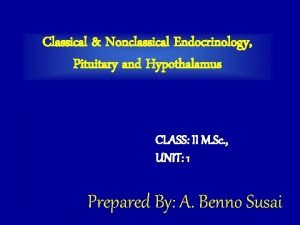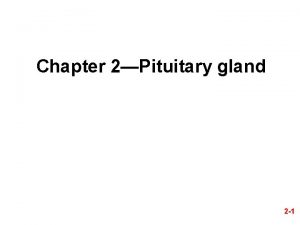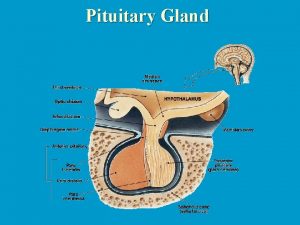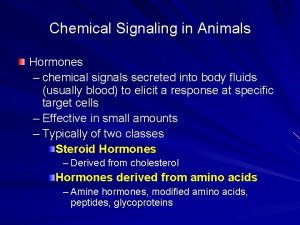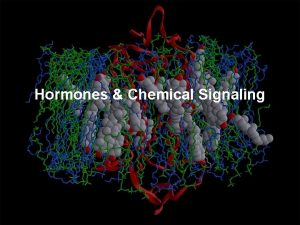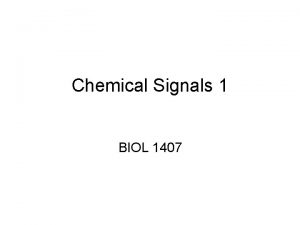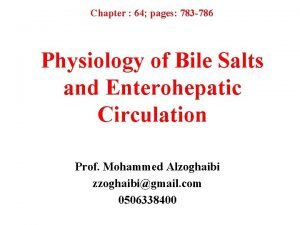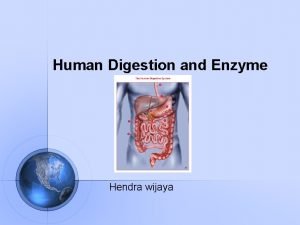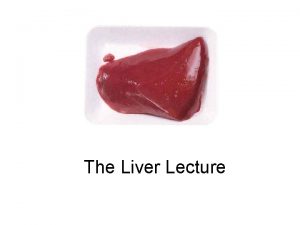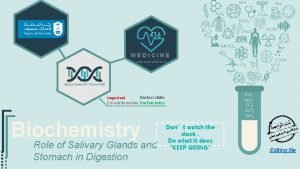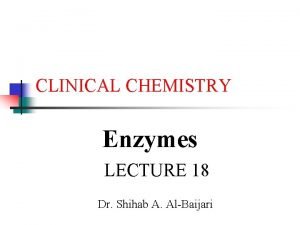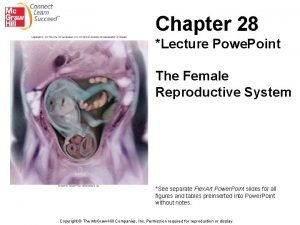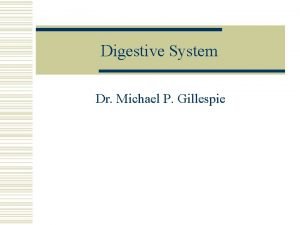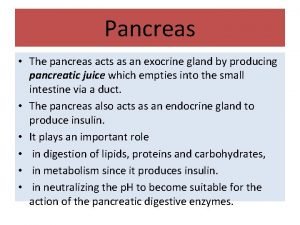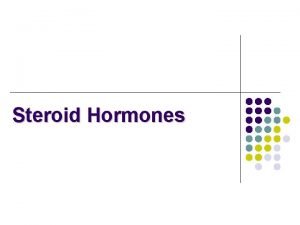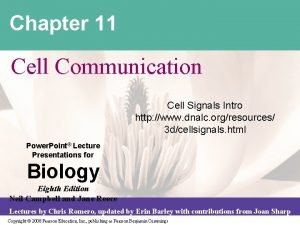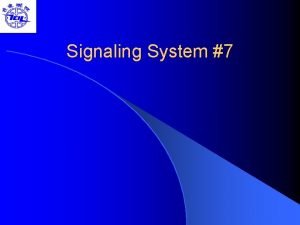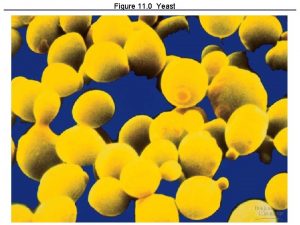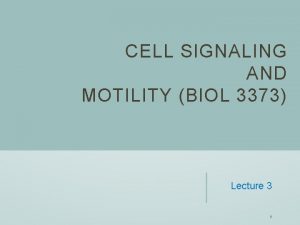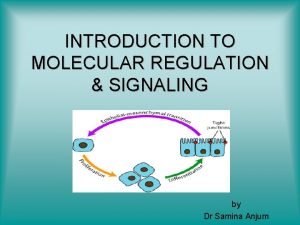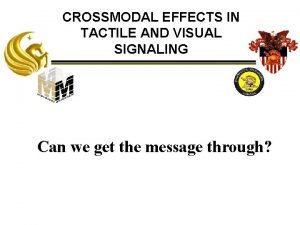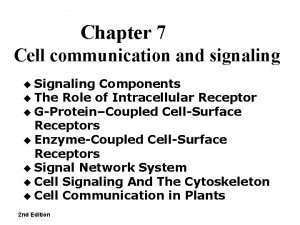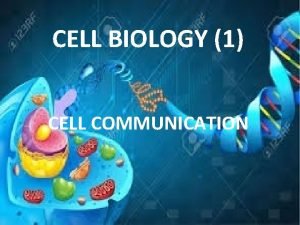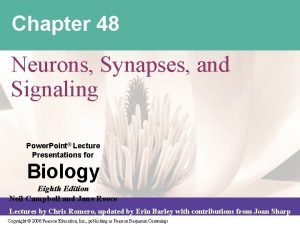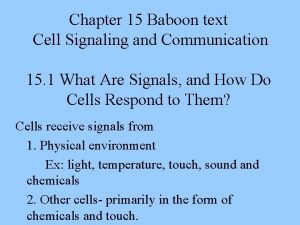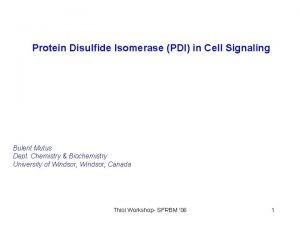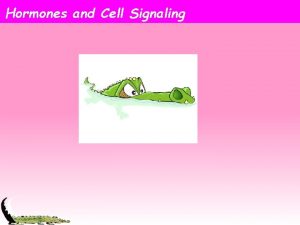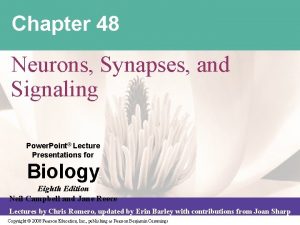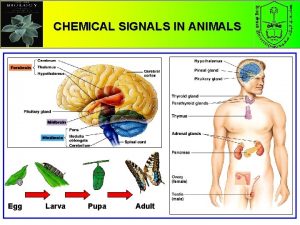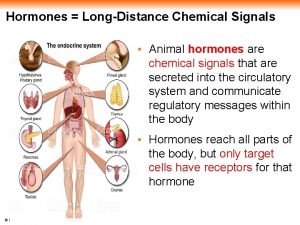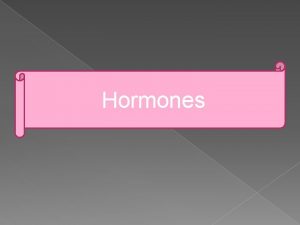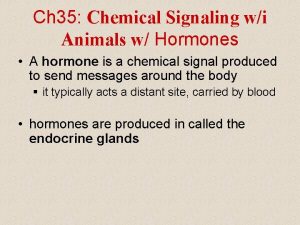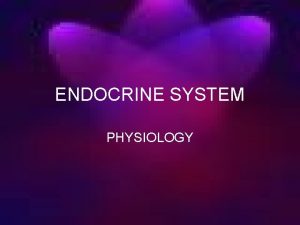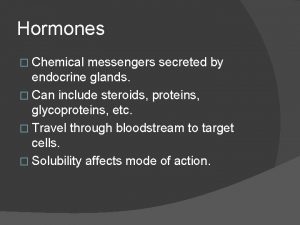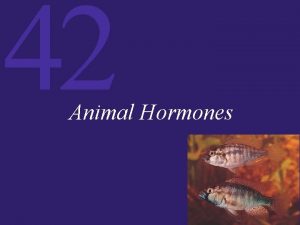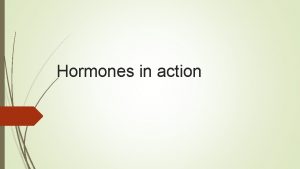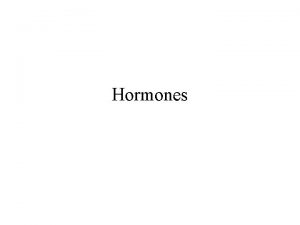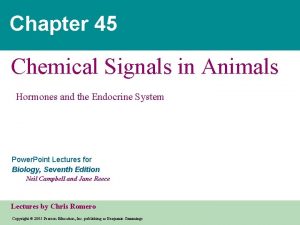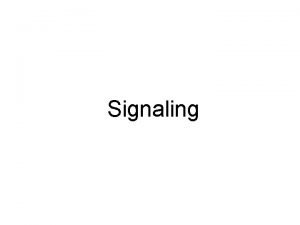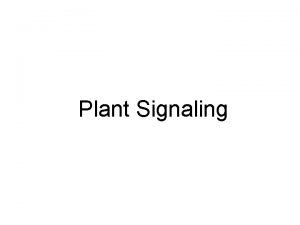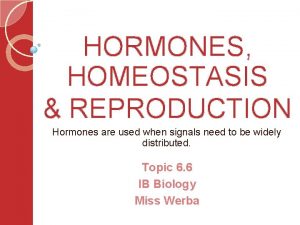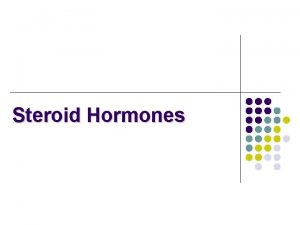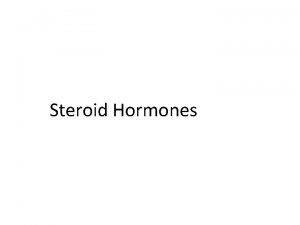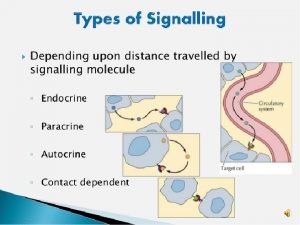Chemical Signaling in Animals Hormones chemical signals secreted
















































- Slides: 48

Chemical Signaling in Animals Hormones – chemical signals secreted into body fluids (usually blood) to elicit a response at specific target cells – Effective in small amounts – Typically of two classes Steroid Hormones – Derived from cholesterol Hormones derived from amino acids – Amine hormones, modified amino acids, peptides, glycoproteins

Regulatory Systems Nervous System – High speed signals along neurons – More direct connections – Use of neurotransmitters Endocrine System – Slower speed signals – Secrete hormones into body fluids – elicit a specific response in target cells elsewhere in the body

Mechanisms of chemical signaling: a review

Endocrine vs Exocrine Endocrine Glands – Ductless glands/no direct connection between cells that secrete the hormones and target cells that respond Exocrine Glands – Ducts carry secreted substances to where they are needed – Ex: digestive enzymes secreted by pancreas

Figure 45. 5 Human endocrine glands surveyed in this chapter

Relationship Between the Nervous System and the Endocrine System Some structural and functional overlap Neurosecretory cells secrete hormones Epinephrine is secreted as a hormone by the adrenal medulla and as a neurotransmitter of the nervous system Nervous system usually uses (+) feedback loops Endocrine system usually uses (-) feedback loops

Figure 45. 1 An example of how feedback regulation maintains homeostasis

Hormones in Invertebrates Ecdysone – Triggers molting of exoskeleton – Triggers development of adult characteristics Juvenile Hormone – Promotes the retention of larval characteristics Balance between E and JH determines development of insects from larva to adult

Figure 45. 2 Hormonal regulation of insect development (Layer 3)

Chemical Signals Pheromones – carry messages between individuals Hormones – carry messages over large distances within the individual Local regulators – effect only local targets

Local Regulators Growth Factors – Peptides and proteins that stimulate cell proliferation – Must be present in the ECF for many types of cells to grow, divide, and develop normally – Names can be misleading since they were named for the first thing they were found to regulate Nitric Oxide – Functions as a neurotransmitter, can kill certain bacterial and cancer cells, relaxes smooth muscle cells

Local Regulators, cont’d Prostaglandins – Modified fatty acids – What aspirin & ibuprofen work to combat – Functions Stimulate smooth muscle contraction (ex induction of labor/an example of positive feedback) Induce fever and inflammation Intensify sensation of pain

Response Pathways Reception – Hormone binds to a receptor either on the surface of the plasma membrane or within the cytoplasm Transduction – Signal transduction pathways – Alter and amplify the signals

Response Pathways, cont’d Response – A change in the cell’s behavior/Have converted an extracellular signal to an intracellular signal – Activation/Inactivation of a specific gene or protein – Note that one hormone can lead to multiple responses depending on target cell – Ex: Acetylcholine, a NT, can stimulate contraction of smooth muscle, relax heart muscle and increase secretions by endocrine cells

Figure 45. 4 One chemical signal, different effects

Steroid Hormones Receptors for steroid hormones are typically in the cytoplasm or nucleus of the target cell The SH/SHR complex acts as a transcription factor in the nucleus Slow acting Turn genes on/off Typically no cascade

Non-Steroid Hormones Typically bind to receptors on the surface of the plasma membrane Typically activate/inactivate proteins via phosphorylation Protein kinases are typically involved

Tropic Hormones Have other endocrine organs as their targets Important in chemical coordination Examples: Gn. RH, FSH, LH, etc

Hypothalamus Integrates endocrine and nervous systems Lower brain receives information from nerves throughout the body and initiates endocrine signals appropriate to environmental conditions Synthesizes both releasing and inhibiting hormones to control the anterior pituitary

Posterior Pituitary Essentially an extension of the hypothalamus Stores and secretes hormones produced in the hypothalamus Oxytocin – Induces contraction of uterine muscles during childbirth – Causes mammary glands to release milk during nursing

Posterior Pituitary, cont’d Antidiuretic Hormone (ADH) – Acts on kidneys to increase water retention and decrease urine volume – Osmoreceptors of hypothalamus signal pituitary to release ADH if necessary/ADH causes kidney to increase water permeability of the collecting duct/(-) feedback

Figure 45. 6 a Hormones of the hypothalamus and pituitary glands

Anterior Pituitary Growth Hormone (GH) – Promotes growth directly – Stimulates production of growth factors (Ex: insulinlike growth factor secreted by liver in response to GH) – Related to growth disorders dwarfism (juvenile), gigantism (juvenile), and acromegaly (adulthood) Prolactin – Very similar to GH, may have evolved from an ancestral gene – Diversity of effects in different species – Stimulates lactation in mammals, regulates fat metabolism and reproduction in birds, regulates salt and fresh water balance in fish

Anterior Pituitary, cont’d Thyroid Stimulating Hormone (TSH) – Stimulates thyroid gland to produce thyroid hormones T 3 and T 4 Follicle Stimulating Hormone (FSH) – Stimulate gonads to produce gametes Luteinizing Hormone (LH) – Stimulates gonads to produce sex hormones All three are glycoproteins

Anterior Pituitary, cont’d Pro-opiomelanocortin – Large protein cleaved into the three hormones listed below Adrenocorticotropic hormone (ACTH) – Stimulates production and secretion of steroid hormones by the adrenal cortex Melanocyte Stimulating Hormone (MSH) – Regulates activities of pigment containing cells in the skin – May play a role in fat metabolism Endorphins – Bodies natural opiates

Figure 45. 6 b Hormones of the hypothalamus and pituitary glands

Pineal Gland Secretes melatonin, a modified amino acid Contains light sensitive cells in some species and may signal day length/changes in season May have an important function in biological clocks Melatonin is secreted at night and more is produced in winter than in summer Influences skin pigmentation, biological rhythms and reproduction in various vertebrates

Thyroid Produces iodine containing hormones related to the amino acid tyrosine T 3/triiodothyronine T 4/thyroxine(converted to T 3 by target cells) Stimulate metabolism and influence development and maturation Disorders include hyper or hypothyroidism and goiter (iodine deficiency) Also secretes calcitonin which lowers calcium levels in the blood

Figure 45. 8 Feedback control loops regulating the secretion of thyroid hormones T 3 and T 4

Figure 45. 7 Two thyroid hormones

Parathyroid Maintain blood calcium levels Parathyroid Hormone – Raises blood calcium levels by effects on bone (breakdown and release calcium to blood) and kidney (stimulates reabsorption of calcium) – If calcium levels are too low, convulsive contractions of skeletal muscles occur – Stimulates kidneys to activate vitamin D which aids intestinal absorption of calcium

Figure 45. 9 Hormonal control of calcium homeostasis in mammals

Pancreas Both an endocrine (2% of pancreas by weight) and an exocrine gland Secretes antagonistic hormones that maintain blood glucose homeostasis Insulin – Secreted by beta cells of islets of Langerhans – Secreted in response to high blood glucose levels – Increases cellular uptake of glucose, promotes formation and storage of glycogen in liver, stimulates protein synthesis and fat storage – Type I diabetes = autoimmune disorder resulting in lack of insulin – Type II diabetes = loss of responsiveness to insulin

Pancreas, cont’d Glucagon – Secreted by alpha cells of islets of Langerhans – Secreted in response to low blood glucose levels – Stimulates conversion of glycogen to glucose, breakdown of fats and proteins

Figure 45. 10 Glucose homeostasis maintained by insulin and glucagon

Adrenal Medulla & Cortex Medulla – Closely related to the nervous system – Releases epinephrine and norepinephrine in response to stress-activated impulses from the nervous system – Fight or flight response

Figure 45. 11 Derivation of endocrine cells of the adrenal medulla and neurons from neural crest cells

Adrenal Cortex and Medulla, cont’d Cortex – Responds to signals from the pituitary – Corticosteroids Glucocorticoids – influence glucose metabolism by promoting synthesis of glucose from non-carbohydrate sources – Suppress the immune system (Ex: cortisone) Mineralocorticoids – Aldosterone affects salt and water balance in kidney

Figure 45. 14 Stress and the adrenal gland

Gonadal Steroids All three types found in both males and females but in different ratios Produced in testes of males, ovaries of females Androgens (highest in males) – Primarily testosterone – Responsible for both primary and secondary sex characteristics as well as reproductive cycles/behavior Estrogens (highest in females) – Primarily estradiol – Responsible for both primary and secondary sex characteristics in females as well as reproductive cycles/behavior Progestins (highest in females) – Primarily progesterone – Responsible for preparing and maintaining the uterus for pregnancy

Overview of Chemical Signaling Hormones from Endocrine Cells – Hormone released from secretory cell, taken up into blood and released from blood, taken up by target cells that are far away from the site of secretion (Ex: pancreas) Hormones from Neurosecretory Cells – Neurons receive signals from other nerve cells and release a hormone into body fluids or into a storage organ from which hormones are later released (Ex: hypothalamus & adrenal medulla)

Types of Chemical Signaling, cont’d Synaptic Signaling – Neurotransmitter molecules are released at synaptic junction to signal an effector in close proximity to the synapse Paracrine Signaling – Local regulator diffuses through interstitial fluid to reach target cells in close proximity (Ex: NO, growth factors, prostaglandins)

Action of Steroid Hormones Steroid hormone crosses plasma membrane Steroid hormone binds to a specific steroid receptor inside the cytoplasm or nucleus of a cell Steroid/steroid receptor complex acts as a transcription factor and turns specific genes in a target cell on or off Target cell specificity – Not all cells produce the steroid hormone receptor – Not every cell turns on/off the same set of genes/other transcription factors may also be involved

Mechanism I for typical non-steroid hormones or local regulators Hormone/local regulator binds to a specific receptor on plasma membrane G protein is activated (GTP binds to G protein) Activated G protein activates adenylyl cyclase which catalyzes the synthesis of c. AMP from ATP (and GTP gets hydrolyzed to GDP +Pi)

c. AMP, a 2 nd messenger, in turn activates c. AMP dependent protein kinase in turn activates a cascade of enzymes involved in phosphorylation/dephosphorylation reactions

Mechanism II for typical non-steroid hormones or local regulators Hormone/regulator binds to a specific receptor on the surface of the plasma membrane Activate a G protein (bind GTP) Activated G-protein activates phospholipase C

Mechanism II for typical non-steroid hormones or local regulators, cont’d Phospholipase C cleaves a specific type of phospholipid of plasma membrane to produce – IP 3 (inositol triphosphate) and – DAG (diacylglycerol)

Mechanism II, cont’d DAG, a 2 nd messenger, can activate protein kinase C which in turn activates a cascade of phosphorylation/dephosphorylation reactions IP 3, a 2 nd messenger, causes cells to release Ca 2+ from intracellular stores (usually endoplasmic reticulum)/ Ca 2+-calmodulin complex activates a cascade of reactions
 Acromegly
Acromegly Hormones secreted by adenohypophysis
Hormones secreted by adenohypophysis Evolution of pituitary gland
Evolution of pituitary gland Chemical signaling
Chemical signaling Chemical signaling
Chemical signaling Chemical signaling
Chemical signaling Communicative signals and informative signals
Communicative signals and informative signals Animals and human language chapter 2
Animals and human language chapter 2 Communicative and informative signals
Communicative and informative signals Functions of bile
Functions of bile Small intestine digestive enzymes
Small intestine digestive enzymes Bile juices
Bile juices Lingual lipase
Lingual lipase Oxytocin is secreted by
Oxytocin is secreted by The main jobs of the large intestine are _____.
The main jobs of the large intestine are _____. Trypsin is secreted by
Trypsin is secreted by Milk is continually secreted into the mammary acini
Milk is continually secreted into the mammary acini Pepsin is secreted by
Pepsin is secreted by Is bile in pancreatic juice
Is bile in pancreatic juice Glucagon is secreted by:
Glucagon is secreted by: Chemical classification of hormones
Chemical classification of hormones Dot
Dot Signaling system 7
Signaling system 7 Loop start signaling
Loop start signaling Phosphorylation cascade
Phosphorylation cascade Ground guide signals
Ground guide signals Cell signaling
Cell signaling Three stages of cell signaling
Three stages of cell signaling Autocrine and juxtacrine signaling
Autocrine and juxtacrine signaling Phrase signal
Phrase signal Use visual signaling techniques
Use visual signaling techniques An embryonic industry is one that
An embryonic industry is one that Cell communication types
Cell communication types Cell signaling overview
Cell signaling overview Ligand signaling molecule
Ligand signaling molecule Juxtacrine communication
Juxtacrine communication Textual aspects of lexical competence
Textual aspects of lexical competence Chapter 48 neurons synapses and signaling
Chapter 48 neurons synapses and signaling Functional professional touch
Functional professional touch 3 types of cell signaling
3 types of cell signaling Pdi cell signaling
Pdi cell signaling Exocrine cell signaling
Exocrine cell signaling Register and signaling vocabulary
Register and signaling vocabulary Chapter 48 neurons synapses and signaling
Chapter 48 neurons synapses and signaling Consumers producers and decomposers
Consumers producers and decomposers Animals that eat both plants and animals
Animals that eat both plants and animals Https://a-z-animals.com/animals/
Https://a-z-animals.com/animals/ Animals that eat both plants and animals
Animals that eat both plants and animals Endocrine glands secrete
Endocrine glands secrete
